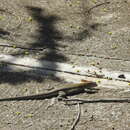pt-BR
nomes no trilho de navegação


The common ameiva (Pholidoscelis chrysolaemus) is a species of lizard endemic to Hispaniola and a number of smaller associated islands. It is known to engage in homosexual mating among males. [2]
The common ameiva was originally described by Edward Drinker Cope in 1868, as Ameiva chrysolaema. The specific epithet likely comes from the Greek chryso, meaning gold, and laimos, meaning neck or throat, for the yellow throat and belly of this species.[3] In 2016, the species was moved to Pholidoscelis based on genetic sequencing and phylogenetic analyses.[4]
There are sixteen accepted subspecies in The Reptile Database.[3] Given the variation among the subspecies, some authors suggest that they probably comprise more than one species.[4]
The common ameiva is considered a species of least concern by the IUCN Red List due to its broad distribution and adaptable nature to modified environments and impacts, such as habitat destruction and urban development. Some subpopulations, such as in Santo Domingo, appear to be in decline due to the loss of backyards and predation by cats.[1]
The common ameiva (Pholidoscelis chrysolaemus) is a species of lizard endemic to Hispaniola and a number of smaller associated islands. It is known to engage in homosexual mating among males.
Pholidoscelis chrysolaema est une espèce de sauriens de la famille des Teiidae[1].
Cette espèce est endémique d'Hispaniola[1].
Selon Reptarium Reptile Database (27 mai 2016)[2] :
Ameiva leberi[3] a été placée en synonymie avec Ameiva chrysolaema[4]. La sous-espèce Ameiva chrysolaema umbratilis a été élevée au rang d'espèce par Goicoechea et al. en 2016[5]